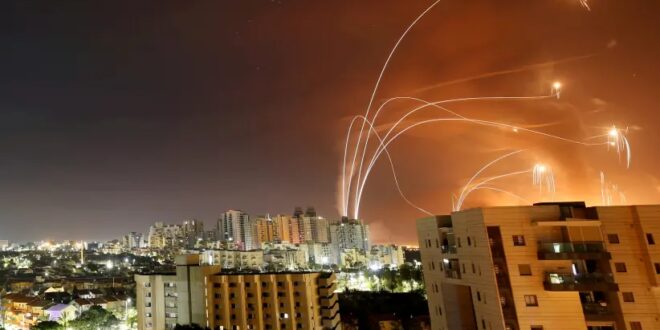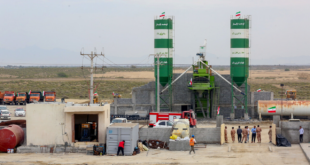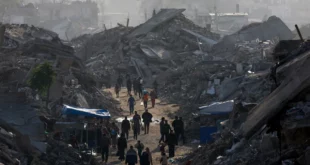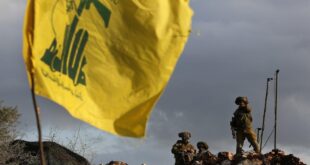The entire world had a front-row seat to the competition, but greater commentary is needed to explain how the race works.
The competition between rockets and the Iron Dome reached a new level of prominence during the recent Gaza Guardian of the Walls operation. Viral videos circulated on social media capturing nighttime bouts between glowing projectiles, as well as the awe of spectators. Yet beyond these dramatic images was a deadly race that informed the fates of Israelis and Palestinians, a race to see which ran out first: rockets or Iron Dome.
The entire world had a front-row seat to the competition, but greater commentary is needed to explain how the race works. The contest occurred on a field of battle in which both rockets and Iron Dome were valuable players working for broader objectives and strategies. If Iron Dome failed to keep up, the operation would have been drastically different.
Behind all the fanfare for Iron Dome is a complicated scorecard for victory. It is more than rockets being intercepted or not. It must be understood that other military actions are informed by which platform outpaces and outlasts the other, and what Iron Dome’s sponsor, the IDF, does in Gaza is largely to rig the race in its favor.
By doing a play-by-play analysis of the contest between the rockets and Iron Dome, we can gain a better understanding of the military necessity of the IDF’s actions, as well as what to expect from future rounds.
Objectives and strategies
The rocket-versus-Iron Dome race occurs on a track set by IDF and Gazan objectives. In war, the terms for victory are largely dictated by the meeting of objectives set by the participants. Different strategies are employed to achieve these objectives.
In Guardian of the Walls, “the IDF had no quantifiable or measurable objectives,” Dr. Avi Jager, a visiting fellow at the International Institute for Counter-Terrorism at IDC Herzliya, told the Magazine.
Instead of hard operational objectives, the IDF has three strategic principles.
“Israel’s strategy is as defensive as it can get,” said Jager. “Israel needed to inflict painful strikes against Hamas, otherwise the latter would not hesitate to initiate another round of confrontation sooner rather than later. Additionally, Israel used this opportunity to preemptively destroy Hamas’ military capabilities.”
Third, Israel sought to reduce the current enemy threat. The rocket race takes place on the last principle.
Rockets present a serious threat to Israel’s civilian population, and comprise the bulk of the enemy’s military operations. Rockets are a danger to life, reduce capacity to live and damage livelihood. To counter this, the IDF has created a defense network that is supposed to reduce the threat until it has been neutralized. The Iron Dome system is central to that strategy.
Iron Dome “allows the IDF to execute a plan knowing it may spur militant groups to retaliate with rocket fire,” Joe Truzman, research analyst at the Foundation for Defense of Democracies’ Long War Journal, told the Magazine. “The Iron Dome allows the IDF to absorb the attacks without causing widespread damage to its populated cities.”
Hamas has more concrete objectives than the IDF. It sought “to obtain more political capital at the expense of the Palestinian Authority,” noted Jager. “Hamas puts the PA in an impossible position. Either the PA joins Hamas and wins the popular vote, but risks civilian and security cooperation with Israel, or it sides with Israel and deepens its image as a collaborator in the eyes of the Palestinians.”
To achieve this objective, Hamas must prove itself to be a powerful threat to Israel. Rockets are a cheap and effective way to do so.
“Rockets are also quite effective as terrorist weapons because they catch a lot of attention and considerably disrupt civilian life, even when they don’t cause any casualties,” Ido Levy, an associate fellow at The Washington Institute for Near East Policy, explained. “Rockets are also relatively low-risk to Hamas operatives since they can be operated far away from their targets.”
The challenger: Rockets
Since the 2005 Gaza Disengagement, rockets have been a favored method of attacking Israeli civilians. Several operations were launched in large part due to increased rocket fire. The arsenals of Gazan terrorists have markedly changed since 2005, and even since Protective Edge seven years ago.
Rockets are “an effective threat that fits the unique characteristics of Hamas’ primary adversary, Israel,” Jager clarified. “Israel is relatively small, and the great majority of its Jewish population is centered across the coastline. In such conditions, missiles and rockets are not statistical weapons but an effective tool to cause real harm.”
Qassam rockets have long made up the bulk of Gazan rocket stockpiles. Qassams are indigenously produced, often made out of “civilian” objects like water pipes. However, their effectiveness shouldn’t be dismissed. Qassams are useful when used en masse to suppress an area. Its warhead is no lighter than a 60 mm mortar round, and they are also generally anti-personnel weapons, relying less on concussive force than the shrapnel packed inside. Qassam variants have also gotten progressively larger, longer range and more destructive. Moreover, Qassams are far from the only rocket used by terrorist organizations.
“Thanks to Iran, rockets are pretty accessible to Hamas and other Gaza-based groups,” said Levy. “Iran provides rockets and technical training to Hamas that has appeared to significantly increase the group’s stockpile and indigenous production capacity.”
Hamas and other terrorist organizations are able to produce Iranian and Russian rockets like Fajrs and Grads. They reportedly have dozens of rockets that can reach Haifa, hundreds that can reach Tel Aviv and thousands that can hit Beersheba. They also have a significant number of short-range rockets and mortar bombs to bombard the Gaza periphery.
In the most recent round, “Several new weapons were unveiled by al-Qassam Brigades and by Palestinian Islamic Jihad’s military wing, Saraya al-Quds. Al-Qassam unveiled several rockets, one called the Ayyash 250, calling it their ‘most powerful rocket,’” said Truzman. “For its part, Saraya al-Quds unveiled the Qasim rocket, reportedly carrying 400 kilograms of TNT.”
The combined arsenal of the Gazan terrorist groups is estimated at over 30,000 projectiles. The cost of producing these rockets varies. Qassams range from $300 to $800, whereas longer-range rockets can cost as little as $1,000. It is more expensive to smuggle rockets and parts than to produce them.
As for delivery to their targets, Gaza has shown it has the rocket infrastructure to consistently launch more than 100 rockets per barrage.
They’ve “learned to increase their range and lethality,” said Truzman. “The rockets have been mass-produced to the point where the militant groups were able to fire more than 4,360 rockets in a period of about 10 days – very close to the amount of all the rockets fired during the seven-week-long Tzuk Eitan [Protective Edge] operation in 2014.”
The defending champion: Iron Dome
The Iron Dome platform is an air and missile defense platform developed by Israel’s Rafael and commissioned by the government. Since the system’s initial deployment in 2011, 10 batteries have come into IDF service. Each battery can hold 20 missiles at a time.
The batteries use Tamir missiles to intercept targets, and often boast a 90% interception rate. The Iron Dome uses a detection system to determine if the trajectory of an enemy rocket poses a threat, so teams engage only if there is imminent danger to a population center.
Each battery is estimated to cost as much as $50 million, plus maintenance and manpower costs. Tamir interceptors are estimated to cost around $40,000-$50,000. Since two Tamirs are launched for each interception, each engagement costs as much as $100,000. Costs for batteries and interceptors are offset by US military aid.
Besides rockets, Iron Dome has shown the ability to intercept mortar bombs and drones.
Iron Dome versus rockets
The race between Iron Dome and Gazan rockets is based on the stamina of three factors: volume, cost, reserves. Whichever side runs out first is the loser.
While Iron Dome is able to intercept 90% of projectiles that pose a threat, heavier barrages may challenge it.
“The militant groups appear to have used a strategy of launching rockets in barrages in an attempt to confront the Iron Dome system,” said Truzman. “Some were able to pierce through the protection bubble and strike civilian areas, killing and injuring Israelis.”
Since 2014, the average Gazan rocket barrage has doubled in volume. If more rockets are launched, more will fall even if the interception rate stays the same. Furthermore, there are only 10 Iron Dome batteries, with a goal of 15. Each battery has 20 interceptors loaded and a fixed rate of fire. There may be an upper limit to the amount of rockets that can be stopped by Iron Dome and once breached, the effectiveness of the platform beyond that limit would drop drastically. If Gazans can create enough rocket infrastructure to maintain a high enough volume of fire, they will be able to consistently pierce the Iron Dome.
Like most military hardware, Iron Dome runs on dollars. Iron Dome presents a significant financial burden on the Israeli military. Each interception costs about $100,000, whereas a Gazan rocket could cost as little as $1,000. Consistent rocket launches could cost hundreds of millions of dollars for the IDF. This pales in comparison to the cost in lives and property damage caused by unhindered rocket fire, but the bill must be paid nonetheless. Each rocket is an attack on the IDF’s bank account.
Given that Tamir missiles are more expensive than Gazan rockets, there is a question as to how many the IDF possesses. After each escalation Israel appeals to the US for resupply aid, and while perhaps procedural, it may also suggest that reserves are far more limited than rockets. That Iron Dome fires two missiles per interception amplifies the problem. The rate of production is also in question. Tamirs are far more complicated than Qassams, and even with modern manufacturing likely take longer to produce. This could mean that during an extended contest, Gazans could restore their rocket stamina faster.
With all these limitations, it would be difficult for Iron Dome to compete without the IDF taking other military actions.
Rigging the race: The best defense is a good offense
The best way to ensure that Iron Dome is not overwhelmed is not to simply bolster the defense system, but to directly reduce Gazan rocket capabilities.
“Iron Dome is protecting the people in Israel, but airstrikes are offensive, and are used to strike Hamas tunnels and rocket launchers. Together you’re most efficient and effective,” an Iron Dome operator told the Magazine.
The IDF has indicated that a significant portion of its attacks within Gaza were devoted to reducing enemy threat capacity, though they haven’t done well at explaining this. During Guardian of the Walls, it stated that the way to “prevent the terrorist organization from firing rockets at Israel is through military strikes.” The rocket-neutralizing focus is also indicated by IDF targets. Samech Mamluch, the head of Palestinian Islamic Jihad’s rocket division, and Juma Tahla, senior Hamas missile R&D official, were just two of the scores of rocket personnel targeted by the IDF. Almost half of the IDF’s infrastructure targets were solely for rocket launching.
“The IDF targeted tunnels, storage locations of rockets, militants actively attempting to launch projectiles toward Israel and commanders, which they were very successful at accomplishing,” noted Truzman. “Initially, it appears the IDF had a wide bank of targets which they had been building over the years.”
There are several ways the IDF can disrupt rocket infrastructure. The most direct way is to destroy the rockets themselves. In 2014, the IDF destroyed an estimated third of Hamas’s rocket stockpile. Depending on the type of rocket, distinct platforms are needed to launch the rockets. Destroying these launchers renders different ammunition useless. The same can be said of the teams that load and operate the launchers. Without trained soldiers to launch the rockets, they can’t be utilized.
“Airstrikes on launch sites, rocket stockpiles and other militant infrastructure help degrade Hamas capabilities to make it stop firing rockets,” said Levy.
Command-and-control sites that organize and direct barrages can also be struck. Destroying operation centers reduces barrage volumes to manageable levels, and lowers accuracy – and thereby the amount of rockets Iron Dome actually has to intercept. Likewise, destroying the means to safely transport rockets and teams, such as underground networks, delays participation.
The IDF can also reduce the resupply rate. Destruction of production sites prevents present and future rearmament. Some munitions are also brought into the Strip through smuggling, in which case increased maritime restrictions and targeting of smuggling tunnels into Egypt will also reduce the resupply rate.
“I’ve had people from the States message me and say that ‘Israel is attacking Gaza and I don’t see why because Israel has Iron Dome and bomb shelters,’” the Iron Dome operator related.
What is poorly understood is that IDF strikes are not done in blind retaliation. There is a threat-reducing logic to them, be it to create deterrence, destroy future threats or to rig the rocket race in favor of its defense network.
Who won the 2021 race?
Tallying the scorecard is difficult, especially when the numbers are not all available. Despite over 4,360 projectiles fired at Israel, Iron Dome maintained its 90% interception rate. While 12 people were killed by rockets, and at least 1,325 buildings and 738 cars were damaged, the outcome could have been far worse. At the end of the day, Iron Dome did not run out of missiles. Its high interception rate means that barrages were unable to reach the point of oversaturation.
As for costs, those are still being calculated, but thankfully the US will help resupply Israel with life-saving defensive missiles. Given that there was no sense of desperation to eliminate the rocket threat as soon as possible, it stands to reason that Iron Dome and the IDF military strikes were successful in countering the Gazan rocket threat and meeting the strategic principles under which they operated.
However, the rockets achieved limited success in meeting its own objectives. Hamas popularity has increased, and has shown itself to be a competent military force.
What if Iron Dome loses the race?
If Iron Dome is not capable of keeping up with rockets, then the consequence would be disastrous for both Israelis and Palestinians. Israelis would be subjected to hundreds of more rockets, resulting in significantly more deaths and damage to property. It would be comparable to that of the Second Lebanon War, which saw similar amounts of rockets and rates of fire.
The IDF would be unable to strike at its leisure, and the urgency of destroying rocket infrastructure would loosen the many IDF restrictions that help prevent Palestinian civilian casualties. A ground invasion would be necessary, as the IDF would likely be unable to address the urgent rocket-fire threat with airstrikes alone.
Future races
Despite the military success of Guardian of the Walls, Iron Dome and the IDF need to be prepared for future races. The amount of rockets and their quality are steadily improving. Terrorists have three times as many rockets as they did in 2014, and were able to fire almost as many as they did in all of Protective Edge within a mere two-week window. Their rockets are more destructive and the range has been extended. It is reasonable to assume these trends will continue to develop.
There also may be qualitative and quantitative improvements in other areas of rocket infrastructure, such as targeting, smuggling and logistics that could enhance the threat. Furthermore, given that the IDF offsets costs and resupply with the aid of its ally the US, it also must take greater care with the race of propaganda, and better explain the purpose of its military strikes. The public-relations front was not a successful one.
With ever-changing conditions for every escalation, the rocket and Iron Dome race shouldn’t be approached as individual sprints of operations, but as part of a much longer marathon of war. While each circuit has its victors, the Gaza marathon may have no winners, only losers.
 Eurasia Press & News
Eurasia Press & News




